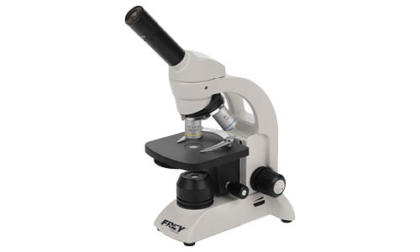Microscopes are an important purchase for a science learning space, but there are quite a few to choose from – depending on what you would like your students to accomplish. Check out this list of the different aspects to consider when choosing new microscopes for your science learning space.
Microscope Factors to Consider Before Purchasing
Making expensive purchases requires consideration — and the right microscopes can play a role in getting students interested in STEM careers. These factors all play a role in choosing the right microscopes for your students:
Shop All Microscopes & Magnifiers
Compound vs Stereo Microscopes:
While compound microscopes use transmitted light and high magnification to view translucent material on slides, stereo microscopes use two eyepieces and light (transmitted and incidental) at lower magnification to view 3D opaque object.
Size:
Compact microscopes work best for students with smaller hands (elementary and middle school) and larger, standard-sized scopes are a better fit for secondary and university students.
Head Type:
Monocular scopes work best for one-on-one use because of their singular eyepiece. Dual head scopes work for group or supervised viewing . Advanced binocular scopes have two stereoscopic eyepieces that make them especially sensitive to light and detail.
Objectives:
Stereo microscopes come in a variety of magnifications including fixed, variable, and variable zoom. Compound scopes have 2x, 4x, and 40x/xR objectives. Some also have a 100x/xR objective.
Stage Features:
Plain stages move up and down, while floating or gliding stages can be moved from side to side by hand. Add-on mechanical stages are mounted on top of a plain stage and can be repositioned. True mechanical stages are controlled by a mechanism that allows you to move the stage from side to side with precision.
Digital Microscopes:
Digital scopes can be plugged into a TV, computer, or projector to be viewed in a larger format.
Cordless Microscopes:
Cordless scopes use eco-friendly, rechargeable batteries. This helps to eliminate safety hazards and make the scopes more versatile (for use outside a traditional classroom space).
Microscope Illumination Options
Hot Illumination:
Tungsten Incandescent
Incandescent bulbs are bright and affordable, but produce heat. They are not suggested for use when viewing live cultures and specimens.
Halogen
Similarly to the incandescent bulbs, halogen bulbs are bright and hot. These are also not suggested for use viewing live cultures and specimens.
Cool Illumination:
Fluorescent
These produce light that is cool and bright, making them a great option for viewing live cultures and other heat-sensitive slides.
LED
The most common choice for microscopes used for education, LED microscopes have an extremely long life.
Get the Right Tools for a Science Learning Space
If you’re looking for more tips and help choosing the best tools for your science space, be sure to read the other useful blogs in the STEAM/STEM category. Also be sure to drop by the online store to find thousands of high quality products and supplies for any student and learning space.
Read More: Choosing the Right Plastic Labware for Your Science Classroom







Leave a Reply